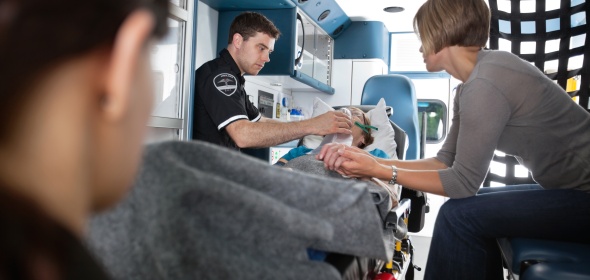By Maile Richardson
Since 2015, the California Emergency Medical Services Authority (EMSA) has been testing the viability of asking paramedics to step outside of their traditional scope of practice. Known as Community Paramedicine (CP), or mobile integrated health (MIH-CP), this model of care aims to improve the effectiveness and efficiency of health care delivery by creating partnerships between existing paramedics and other health care providers in local settings.
Healthforce Center has been serving as an independent evaluator for this pilot project and helping EMSA assess the success of different CP concepts being implemented across California:
- Short-term, home-based follow-up care for people recently discharged from a hospital due to a chronic condition
- Case management services for people who are frequent 911 callers and frequent visitors to emergency departments (EDs)
- Directly observed therapy (DOT) for people with tuberculosis (i.e., dispense medications and observe patients taking them) in collaboration with a public health agency
- Collaboration with hospice agency nurses, patients and family members to treat patients in their homes according to their wishes, instead of transporting them to an ED in response to 911 calls
- In response to 911 calls, CPs offer alternatives to the ED including mental health crisis centers, urgent care centers and sobering centers, depending on patients’ needs
Healthforce’s assessment has found reductions in preventable ambulance transports, emergency department visits and hospital readmissions. They have not resulted in any adverse outcomes for patients. California Health Care Foundation’s (CHCF) senior engagement officer, Avram Goldstein, traveled around California to meet community paramedics and record first-hand accounts of their experiences in the field.
Anne Jensen, City of San Diego
Anne spoke about a patient whose homelessness and alcoholism had him calling 911 on average 40 times a month. By providing crisis intervention and coordinated medical care, she was able to help this person stabilize and become sober for about a year. Though this particular patient has relapsed on occasion, Anne is heartened that his calls have decreased to about two times a month. “Every community has individuals who have circumstances that are so complex that they need help from multiple systems of care and it’s too hard for one system of care to deal with alone,” Jensen said. “A community paramedic can come in and help the systems of care work together. And that really helps for those patients who are in perpetual crisis. It’s just better care for the patients.” Learn more from the California Health Care Foundation:
Dennis Flannery, Stanislaus County
Dennis relayed his experiences about patients who are having mental health issues. While psychiatric emergencies are serious, sometimes they do not warrant a trip to the emergency room, as other emergency medical needs would. “Given the opportunity, we might be able to… take them to an alternate destination that will better suit their needs and better address their psychiatric condition more efficiently, more quickly.” He also spoke to how readily law enforcement is backing this new system. Patients are able to have their health needs effectively met, rather than being detained by the sheriff or police department. This allows law enforcement to freely and quickly get back to policing their communities. Learn more from the California Health Care Foundation:
Patrick Corder, City of Alameda
Paramedics are a major part of any emergency first response. But for Patrick, as a CP, he sees the opportunity to be one of the people working to stop problems before they happen. “They can do all the work on the patient when the patient is in the hospital. They can get all sorts of care plans set up, but as soon as that person leaves the hospital, the hospital themselves don’t have the boots on the ground to be able to go out and engage with these folks in their homes, on their own terms. The writing is on the wall. We need to start working proactively with the people that we see on a regular basis to be able to provide better care and ultimately to affect all the other systems under the healthcare umbrella. It’s good for your department. It’s good for the patient population. It’s good for everybody. It’s a no-loss situation. It’s win-win.”
Learn more from the California Health Care Foundation:
Check back to keep up with the latest information about the Community Paramedicine Pilot Projects.
Join Us
Want more information about the latest trends in the health care workforce? Sign up for our newsletter to get research insights, news and leadership opportunities.
About Maile
Maile Richardson is an associate with Healthforce Center. She supports multiple leadership programs and is interested in diversity and equity in the health care industry.
